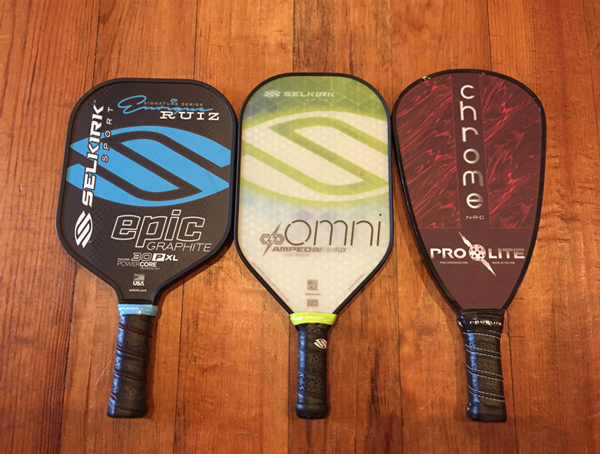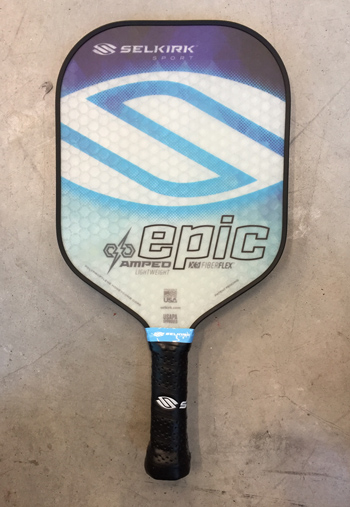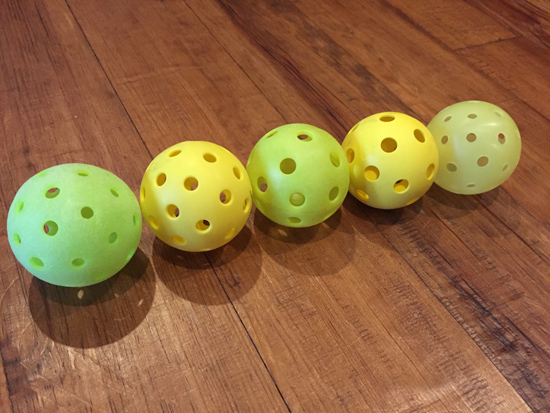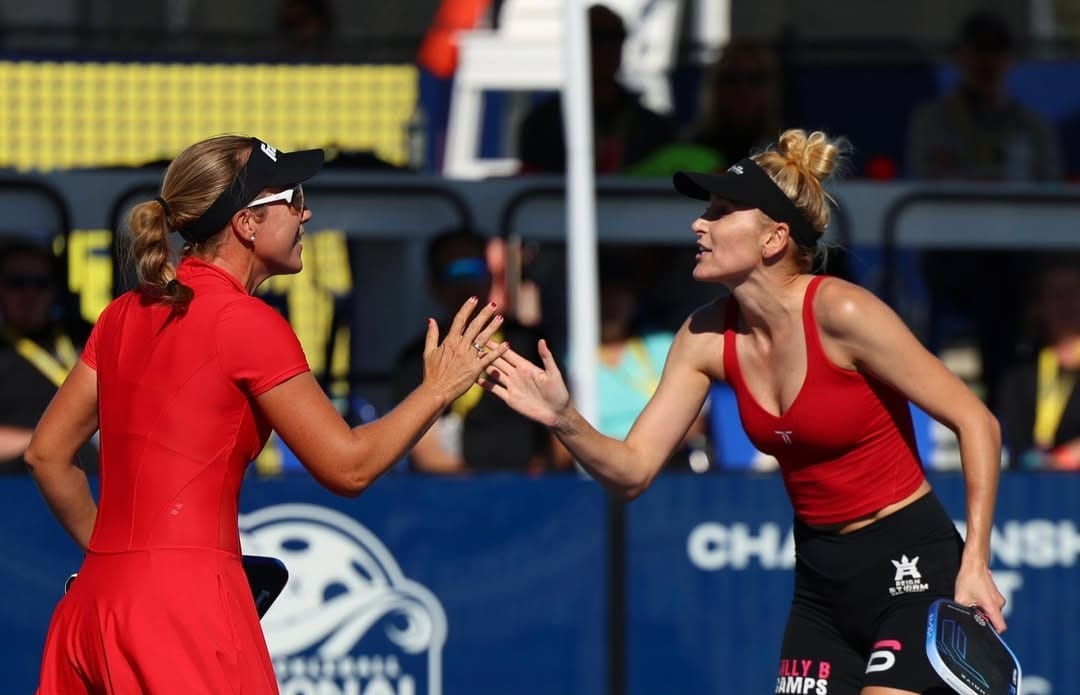Welcome to pickleball! I’m super excited that you’re here to learn about the basics of this wonderful sport. This is an article for the absolute pickleball beginner. If you don’t know anything about pickleball, don’t worry, I’m going to give you all the juicy details!
As a game, pickleball works just like any other racket sport. At the most fundamental level, it’s a game where you hit a ball over the net. If you hit it into the net or you don’t hit it within the lines, you lose! Sounds easy, right?
Hold your horses! Pickleball is a bit more complicated than that. Although pickleball is incredibly easy to learn, mastering pickleball is a different story.
But today we’re not going to talk about mastering pickleball. I’m going to give you the basics of pickleball so that you can get started on the right foot. Let’s go!
First, some myth-busting
There are a few myths that crawl through the grapevine that need some serious debunking. Here are a few of them that are important to understand before you get started.
Pickleball is miniature tennis
If you’re a previous tennis player, this is extremely important. Besides the obvious elements like courts, lines, nets, and balls, pickleball is nothing like tennis. They are two completely and fundamentally different sports.
If you’re coming from tennis, please understand that the skills you have as a tennis player can certainly cross over, but most of it will get lost in translation. Pickleball is not miniature tennis.
Pickleball is just for seniors
This is so false it’s almost hilarious! I’m surprised that you still hear this every now and then. The reason why this myth circulates is that pickleball became popular because of retirement communities.
But since then, it has exploded in popularity and is growing among all age groups. In fact, we’re starting to see a lot of young teenagers pick up the sport and they are terrifyingly good at it.
Pickleball is injury-free!
This is a dangerous myth. Pickleball is not easier on your body, it’s just easier to perform. Tennis is harder on your body than pickleball because you have to cover more ground.
But that doesn’t mean that pickleball is easy on your body or somehow “ultra-safe” to play. I hear about pickleball-related injuries all the time. In fact, I’ve incurred a few of my own.
Let’s look at a pickleball court
To start off, let’s get a bird’s eye view of what we’re dealing with.
We all know what a tennis court generally looks like. But what about pickleball? Just to give you an idea of how big a pickleball court is, check out this image:

A pickleball court is 20’ x 44’. As you’d expect, there is a net that separates the two teams. The net is 36″ high on the sides, and 34” high in the center.
Pickleball courts are very similar to tennis courts. They have lines, nets, and zones just like you’d expect. But there are some differences.
For example, the service courts go all the way to the baseline in pickleball. And the court is the same size for doubles and singles.
But the biggest difference between a tennis court and a pickleball is actually one of the elements that makes pickleball unique.
The kitchen.
Yes, you read that right.
The kitchen, (properly known as the non-volley zone), is the most important section on the court to understand.

Don’t stand in the kitchen…sometimes!
The most important thing to understand about the kitchen, or the non-volley zone, is that you cannot be standing in the kitchen and volley the ball at the same time. This includes the line! If you’re new to racket sports, a volley is when you hit a ball out of the air without it having bounced first. It is strictly forbidden.
This is why when you watch pickleball, you see players standing at the kitchen line hitting the ball softly over. They don’t want to be standing in the kitchen just in case they get a fast ball at them. Becuase if they’re standing in there and they hit the ball out of the air, it’s automatically a fault.
If you want to learn more about the kitchen, please head over here to read my article about it. It will give you many, many more details.
Basic equipment
There are many pieces of equipment that you can buy to fuel your pickleball passion. I want to touch on three of them today.
Pickleball paddles
There are no rackets in pickleball; there are only paddles. These paddles are made of a solid material that’s attached to a handle, just like table tennis paddles. However, they’re much bigger than table tennis paddles, and much smaller than tennis rackets. A typical paddle will measure about 15″ high and weigh around 8 oz.

There are many, many different shapes, sizes and types of pickleball paddles out there. The left one you see in the image above is the standard pickleball paddle shape. Something around 8″ wide and 15″ tall is what you’ll see the most.
Paddles these days are referred to as “composite paddles”. This just means that the paddle is made of multiple different pieces. The pieces are the core, the face, the handle and the edgeguard.
The core of a paddle is what the bulk of the paddle is made out of. Most paddle cores are made of plastic and are manufactured as a block of honeycomb. This creates a core that is strong, but lightweight.
 See the honeycomb pattern? That’s inside the paddle, behind the semi-transparent face!
See the honeycomb pattern? That’s inside the paddle, behind the semi-transparent face!The face of a paddle is what covers up this core material as you can see above. Faces can be made of many different types of materials. Some of the most popular ones are graphite and fiberglass. The face gives the paddle an even hitting surface.
If you’re getting started in pickleball, the most important thing for you to know about paddles is to not buy one that’s too expensive. There’s no need to spend $150 right off the bat.
If you need help picking a paddle, I’ve got the perfect guide for you.
Pickleballs
A pickleball is basically a plastic shell with holes in it. Some people call them big whiffle balls, but we pickleball players just call them pickleballs.
The unique thing about pickleballs, as you can see below, is that they come in many different shapes and sizes.
Basically, some pickleballs are made for indoor play, where others are made for outdoor play. For example, the pickleballs you see below with the bigger holes are for indoor play. The ones with the smaller holes are for outdoor play to help with the wind.

Out of all the racket sports that use a ball, a pickleball will be the one that bounces the lowest. If you come from squash, racquetball, or tennis, you will be shocked at how low the ball bounces! Believe it or not, this is by design!
Shoes
Behind tennis elbow, one of the most common injuries that you see in pickleball is foot and ankle related.
I’ve seen people roll their ankles, or even worse, fall. It’s not fun and it’s dangerous.
To alleviate this, pickleball players wear court or tennis shoes just like tennis players or any other athlete who plays on a court-like surface. It doesn’t matter that pickleball is easy to play. People fall all the time because they’re not wearing the right type of shoes.
And by the right type of shoes, I’m not talking about running shoes! Running shoes are terrible to use for pickleball because they will not withstand the side-to-side movements that you see all the time in pickleball. Get tennis or court shoes instead.
How does the serve work in pickleball?
We all know what a tennis court generally looks like. But what about pickleball?
The serve in pickleball is underhanded. I know, it sounds ridiculous, but it’s for a good reason.
 This is a freeze frame from my video on serving.
This is a freeze frame from my video on serving.As we talked about earlier, the court is only 44 feet long. If you were allowed to serve overhanded, the sheer speed of the ball would be impossible to get. The original founders of the game wanted the game to be fair for all ages. An underhanded serve helps with this.
But just because the serve is underhanded, that doesn’t mean that it lacks power. It’s true that you get more power from an overhanded serve, but you can still get some decent power by doing the right things.
Basic rules
All of the rules that typically apply to other racket sports also applies to pickleball. Things like not letting the ball bounce twice on your side or hitting the ball into the net or outside the lines.
But pickleball has a few extra rules that make the game unique. The two unique rules that I’ll be discussing are what make the game of pickleball fair. When the founders were designing the game,
The double bounce rule
This rule is a bit of a misnomer. It doesn’t mean what it sounds like. Always remember, if the ball bounces twice, the point is over! You can never let the ball bounce twice.
This rule actually deals with the first few shots of the game.
The double bounce rule says that the ball has to bounce once after the serve and then again after the return.
The kitchen rules
I briefly mentioned earlier in the article about the kitchen, or non-volley zone. This is one of the most complicated, yet most critical rules to understand in the game.
The kitchen rule is simply this:
You cannot be standing in the kitchen, and volley the ball at the same time.
That’s it! Again, a volley is a ball that is hit out of the air without it having bounced first. But it gets a bit more tricky than this.
It’s not just hitting a ball out of the air. The rule goes into more details saying that you can’t have been standing or will be standing in the kitchen. This means that you can’t have been standing in the kitchen and volley the ball without having reset your stance first. And, you can’t be standing in the kitchen after you hit the ball as well. This means that if your momentum takes you into the kitchen after a volley, then that’s a fault!
If you’re confused, don’t worry about it. Everyone messes up on the kitchen rule when they first start. It’ll make more sense as time goes on.
What is a dink in pickleball?
The dink shot is one of the most important shots in pickleball. As I will explain below, keeping the ball low is one of the keys to playing pickleball properly. The higher you hit the ball to your opponent, the most powerfully they can smash the ball back at you.
The key to keeping this from happening is the dink. A dink is simply a shot that is low over the net and bounces in the kitchen.
 Dinking at the kitchen
Dinking at the kitchenIf you start playing pickleball, you will hear this word approximately 8 billion times throughout a year of playing. It’s just that important!
Learning how to dink properly is especially important when you’re playing people who are better than you. The higher the ball is for them, the more likely they are to smash it back over and you will lose when this happens!
Basic strategy
I won’t go into depth about the complex strategy that’s involved in pickleball because there’s a lot! However, I do want to give you some basics so that your first day of pickleball will be smooth.
Get to the kitchen line!
Getting to the kitchen line quickly is one of the core principles of pickleball strategy. Everything begins with this.
If you’ve played any amount of tennis, this will take a very long time to get used to. Getting to the kitchen line isn’t necessarily a strategic decision, it’s just what you do every single point of the game.

Check out the image above. This is how the first three points of the game work. The whole point of these shots is to just get the game going. After that, you want to get to the kitchen line as quickly as you can without breaking the double bounce rule.
From there, you’ll be in the dinking game. This is where you hit soft shots over the net until someone makes a mistake.
How do you keep score?
Some people say that scoring is the hardest part of pickleball. I agree. It can be quite complicated for new players. But with a little help and practice you’ll get used to it.
So here’s how scoring works in pickleball:
- Scoring works in sequential numbers. Example: 1, 2, 3. Not 15, 30, 40 like in tennis.
- Each team gets to serve at least twice, one serve for each player.
- You can only score points when your team is serving.
- When you score a point, you switch place with your partner and serve again.
- When a team gets the ball back to serve, the person on the right always serves first.
What this all means is that when your team gets the ball, the player on the right serves and that player is the first server. This is actually notated in the score that you call out. Here comes the hard part. Ready? The score has 3 numbers in it.

The first number you call out will be your score. The next number is your opponent’s score. And the last number is the server number. This will either be 1 or 2 and denotes which serve is currently serving. Ugh, I know! Confusing.
When you get possession of the ball, the player on the right will serve first. They are the first server. So the score, as an example, will be X-X-1. If you were to hit it into the net, then your partner will serve next. Now the score is X-X-2.
Those are the basics. Here’s the catch. At the beginning of a game, the team that serves first only gets to serve once. I know that’s a handful of information to take in, you can head over here to get more details on scoring.
That’s it for the basics!
I hope that this article helped you out in your quest of understanding the basics of pickleball! It’s a lot of information to take in, but believe me, pickleball is easy to play. There are just a few things to pick up and get used to! Thanks for reading! If you have any questions please let me know in the comments!
Anuncie Aqui / Advertise Here
Sua marca para o mundo Pickleball! / Your brand for the Pickleball world!

 English
English  Spanish
Spanish  Portuguese
Portuguese  German
German  Italian
Italian  Japanese
Japanese  French
French  Polish
Polish  Russian
Russian  Netherlands
Netherlands  Hungarian
Hungarian  Turkish
Turkish  Videos
Videos  Pickleball Kitchen
Pickleball Kitchen








 English (US) ·
English (US) ·  Portuguese (BR) ·
Portuguese (BR) ·